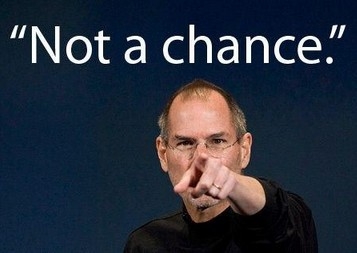To Be on Your Own
靠自己
“The best thing ever to happen to Steve is when we fired him, told him to get lost,” Arthur Rock later said. The theory, shared by many, is that the tough love made him wiser and more mature. But it’s not that simple. At the company he founded after being ousted from Apple, Jobs was able to indulge all of his instincts, both good and bad. He was unbound. The result was a series of spectacular products that were dazzling market flops. This was the true learning experience. What prepared him for the great success he would have in Act III was not his ouster from his Act I at Apple but his brilliant failures in Act II.
“對于史蒂夫來說,最好的事情就是我們解雇了他,叫他滾蛋。”亞瑟·羅克之后說道。許多人也認為,這種嚴厲的愛讓喬布斯更明智,更成熟。但事情并非如此簡單。離開蘋果后,在自己創建的新公司里,喬布斯能夠釋放自己的所有天性,無論好壞。他自由了。結果是一系列炫目的產品,但都遭遇了市場失敗的重挫。這才是真正的學習經驗。他后來的巨大成功,并非因為在蘋果的下臺,而是下臺后華麗的失敗。
The first instinct that he indulged was his passion for design. The name he chose for his new company was rather straightforward: Next. In order to make it more distinctive, he decided he needed a world-class logo. So he courted the dean of corporate logos, Paul Rand. At seventy-one, the Brooklyn-born graphic designer had already created some of the best-known logos in business, including those of Esquire, IBM, Westinghouse, ABC, and UPS. He was under contract to IBM, and his supervisors there said that it would obviously be a conflict for him to create a logo for another computer company. So Jobs picked up the phone and called IBM’s CEO, John Akers. Akers was out of town, but Jobs was so persistent that he was finally put through to Vice Chairman Paul Rizzo. After two days, Rizzo concluded that it was futile to resist Jobs, and he gave permission for Rand to do the work.
他得以放縱的第一個天性便是對設計的熱情。他為新公司選擇的名稱相當簡單:Next。為了讓其更加與眾不同,喬布斯決定,需要設計一個世界級的標識。于是,他設法找到企業標識大師保羅·蘭德(PaulRand)。當時,這位出生于布魯克林的平面設計師已經71歲,他曾設計出商界最知名的一些標識,包括《君子》雜志、IBM、西屋電器、美國廣播公司以及聯合包裹服務公司(UPS)。蘭德當時已與IBM簽訂了合作協議,IBM公司的管理者表示,蘭德為另一家計算機公司設計標識顯然會造成沖突。于是,喬布斯拿起電話打給IBM的CEO約翰·埃克斯(JohnAkers)。埃克斯當時不在,喬布斯非常執著,最后聯系到了的副董事長保羅·里佐(PaulRizzo)。兩天后,里佐發現要拒絕喬布斯簡直就是不可能的,于是,許可了蘭德為這家新公司設計標識。
Rand flew out to Palo Alto and spent time walking with Jobs and listening to his vision. The computer would be a cube, Jobs pronounced. He loved that shape. It was perfect and simple. So Rand decided that the logo should be a cube as well, one that was tilted at a 28° angle. When Jobs asked for a number of options to consider, Rand declared that he did not create different options for clients. “I will solve your problem, and you will pay me,” he told Jobs. “You can use what I produce, or not, but I will not do options, and either way you will pay me.”
蘭德飛到了帕洛奧圖,同喬布斯一同走了走,聽取了他的構想。喬布斯說,計算機將是一個立方體。他喜歡這種形狀,完美而簡單。因此,蘭德決定將標識也做成立方體效果,并且傾斜28度,活潑漂亮。喬布斯詢問蘭德能否做出幾個備選方案來供自己考慮。蘭德表示,自己從不為客戶做不同的備選方案。“我解決你的問題,你付錢給我。”他告訴喬布斯,“我設計出來的東西你用也行,不用也罷,都得付錢給我,但是我不做備選。”
Jobs admired that kind of thinking, so he made what was quite a gamble. The company would pay an astonishing $100,000 flat fee to get one design. “There was a clarity in our relationship,” Jobs said. “He had a purity as an artist, but he was astute at solving business problems. He had a tough exterior, and had perfected the image of a curmudgeon, but he was a teddy bear inside.” It was one of Jobs’s highest praises: purity as an artist.
喬布斯很欽佩這種想法。他對此也有同感。于是,喬布斯作出了賭博般的決定——以10萬美元的費用,讓蘭德為新公司設計一個標識。“我們的關系非常清楚,”喬布斯說,“他具有藝術家的純粹品質,但精于解決商業問題。他外表強硬,像個倔老頭,但是內心就和泰迪熊一樣。”這是喬布斯所給予過的最高評價之一:藝術家的純粹品質。
It took Rand just two weeks. He flew back to deliver the result to Jobs at his Woodside house. First they had dinner, then Rand handed him an elegant and vibrant booklet that described his thought process. On the final spread, Rand presented the logo he had chosen. “In its design, color arrangement, and orientation, the logo is a study in contrasts,” his booklet proclaimed. “Tipped at a jaunty angle, it brims with the informality, friendliness, and spontaneity of a Christmas seal and the authority of a rubber stamp.” The word “next” was split into two lines to fill the square face of the cube, with only the “e” in lowercase. That letter stood out, Rand’s booklet explained, to connote “education, excellence . . . e = mc2.”
蘭德只用了短短兩周就完成了工作。他再次飛到帕洛奧圖,來到喬布斯在伍德賽德的家中,送上了設計結果。他們先是共進晚餐,然后,蘭德遞給喬布斯一個雅致而顏色鮮艷的小冊子,里面描述了自己的構思過程。冊子的最后一頁,蘭德呈現了自己選擇的標識。“從設計、色彩搭配和定位來看,這個標識就是對比的杰作,”他的小冊子中寫道,“傾斜角度活潑漂亮,它充滿了隨和、友善、圣誕貼紙般的自然,以及椽皮圖章式的權威感。”“Next”這個詞被分成了兩行,填補了立方體的立面,只有“e”是小寫,從整個詞中脫穎而出,蘭德的小冊子將“e”解釋為“教育,卓越……e=mc”
It was often hard to predict how Jobs would react to a presentation. He could label it shitty or brilliant; one never knew which way he might go. But with a legendary designer such as Rand, the chances were that Jobs would embrace the proposal. He stared at the final spread, looked up at Rand, and then hugged him. They had one minor disagreement: Rand had used a dark yellow for the “e” in the logo, and Jobs wanted him to change it to a brighter and more traditional yellow. Rand banged his fist on the table and declared, “I’ve been doing this for fifty years, and I know what I’m doing.” Jobs relented.
有時很難預測喬布斯對于某個東西的反應。他可能會認為它很低劣,也可能覺得它很杰出,但你絕對猜不到他會是哪一種反應。但是面對蘭德這樣的傳奇設計師,喬布斯很有可能接受他的創意。喬布斯盯著最后一頁,抬頭看了看蘭德,擁抱了他。不過,他們有一個小分歧:蘭德在字母“e”上使用了暗黃色,而喬布斯希望能改成更為明亮和傳統的黃色。蘭德用拳頭猛擊桌子,說:“我做這行已經50年了,我知道自己在做什么。”喬布斯妥協了。











